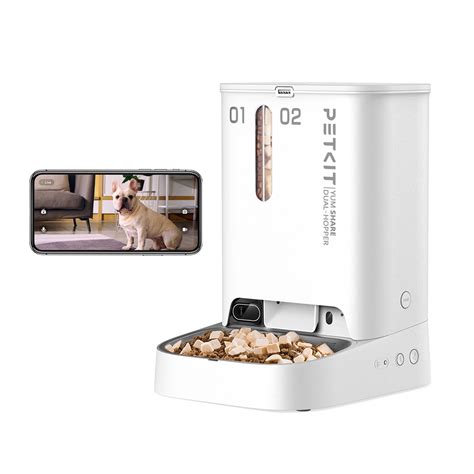Introduction
Feeding your feline companion should be a seamless and stress-free experience. While traditional cat feeding methods involve manual filling and monitoring, the advent of automatic cat feeders with camera monitoring has revolutionized pet care. This article delves into the advantages and disadvantages of both methods, providing insights to help you make an informed decision for your beloved cat.

Automatic Cat Feeder with Camera Monitoring: The Future of Cat Feeding
Benefits
- Convenience: Automated feeders operate on a programmable schedule, eliminating the need for manual feeding and ensuring your cat is fed consistently at the desired times.
- Remote Monitoring: Built-in cameras allow you to keep an eye on your pet, even when you’re away. You can monitor feeding habits, check on their well-being, and interact with them remotely.
- Portion Control: Portion control helps prevent overfeeding and obesity, promoting healthy weight management and reducing the risk of related health issues.
- Data Monitoring: Some feeders provide data insights into feeding patterns, helping you identify any changes or anomalies that may warrant attention.
- Peace of Mind: Knowing that your cat is being fed regularly and on time provides peace of mind, especially when you have a busy schedule or travel frequently.
Drawbacks
- Cost: Automatic feeders with camera monitoring are typically more expensive than traditional feeding methods.
- Technology Reliance: These feeders rely on electricity and Wi-Fi connectivity, which can pose issues if there are power outages or internet disruptions.
- Maintenance: Automated feeders require regular cleaning and maintenance to ensure optimal functioning.
Traditional Cat Feeding: The Simpler Option
Benefits
- Low Cost: Traditional feeding methods, such as gravity-based feeders or manual feeding, are more affordable compared to automatic feeders.
- Ease of Use: Gravity-based feeders or simple bowls are easy to use and require minimal setup.
- No Technology Reliance: Traditional feeding does not require electricity or Wi-Fi, making it a reliable option even in case of power failures.
- Flexibility: Traditional methods offer more flexibility in terms of feeding schedules and portion sizes.
Drawbacks
- Inconsistent Feeding: Manual feeding relies on human remembrance, which can lead to irregular feeding schedules and overfeeding.
- No Remote Monitoring: Traditional feeding methods do not allow for remote monitoring of feeding habits or cat well-being.
- Lack of Portion Control: Gravity-based feeders or simple bowls do not provide portion control, making it difficult to prevent overfeeding.
Comparing Automatic Cat Feeder with Camera Monitoring VS Traditional Feeding
| Feature | Automatic Cat Feeder with Camera Monitoring | Traditional Cat Feeding |
|---|---|---|
| Convenience | High | Low |
| Remote Monitoring | Yes | No |
| Portion Control | Yes | No |
| Data Monitoring | Yes (some models) | No |
| Cost | High | Low |
| Technology Reliance | Yes | No |
| Maintenance | Moderate | Minimal |
| Flexibility | Low | High |
Making an Informed Decision
The choice between an automatic cat feeder with camera monitoring and traditional feeding depends on your lifestyle, budget, and cat’s needs.
- If you value convenience, remote monitoring, portion control, and data insights, an automatic feeder with camera monitoring may be the ideal choice.
- If you prefer a more affordable and low-maintenance option, traditional feeding methods may be sufficient for your needs.
Improving the Automatic Cat Feeder Experience
- Consider the Capacity: Ensure the feeder has sufficient capacity to meet your cat’s feeding needs, especially if you have multiple cats or extended periods of absence.
- Monitor Feed Levels: Regularly check the feeder to ensure it’s filled and functioning properly to avoid interruptions in your cat’s feeding schedule.
- Set Realistic Feeding Schedules: Avoid feeding too frequently or excessively as this can lead to weight gain and other health issues. Consult with your veterinarian for recommended feeding amounts.
- Introduce the Feeder Gradually: Introduce the automatic feeder slowly to your cat to allow them time to adjust and avoid stress or anxiety.
- Ensure Remote Access: Test the remote monitoring capabilities regularly to ensure you can access the feeder and camera remotely from different locations.
Enhancing Traditional Cat Feeding
- Establish a Feeding Routine: Create a consistent feeding schedule and stick to it as much as possible to promote regular feeding patterns.
- Use a Portion Control Bowl: Invest in a portion control bowl to help prevent overfeeding and maintain your cat’s healthy weight.
- Consider a Gravity Feeder: Gravity-based feeders provide continuous access to food but may not be suitable for cats prone to overeating.
- Monitor Your Cat’s Appetite: Observe your cat’s appetite and adjust the amount of food provided accordingly.
- Consult a Veterinarian: Consult with your veterinarian for personalized feeding recommendations based on your cat’s breed, age, and health status.
Future Innovations in Automatic Cat Feeding
The future of automatic cat feeding holds exciting possibilities for pet owners. Some potential innovations include:
- Smart Feeders with AI: Feeders that use AI to monitor and adjust feeding schedules based on your cat’s appetite, activity levels, and other parameters.
- Biometric Feeders: Feeders that use facial recognition or other biometric technologies to identify individual cats and provide personalized feeding experiences.
- Self-Cleaning Feeders: Automated feeders that incorporate self-cleaning mechanisms to maintain hygiene and prevent bacterial contamination.
Conclusion
Choosing between an automatic cat feeder with camera monitoring and traditional feeding involves considering factors such as convenience, remote monitoring capabilities, portion control, and budget. Automatic feeders offer advanced features but require higher investment and technology reliance, while traditional feeding is more affordable and less dependent on technology. Whichever method you choose, ensure it meets your needs and promotes your cat’s health and well-being. With ongoing advancements in technology, the future of cat feeding promises even more innovative and convenient solutions for pet owners.





















